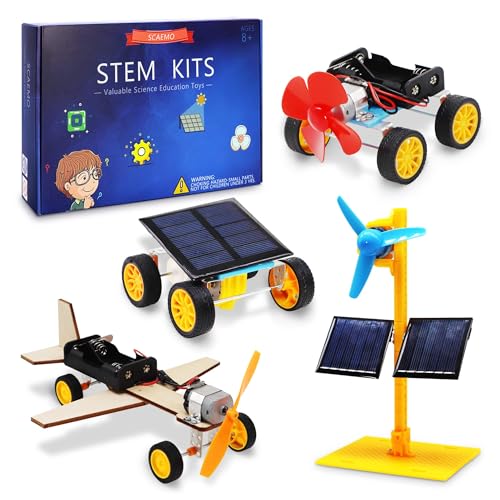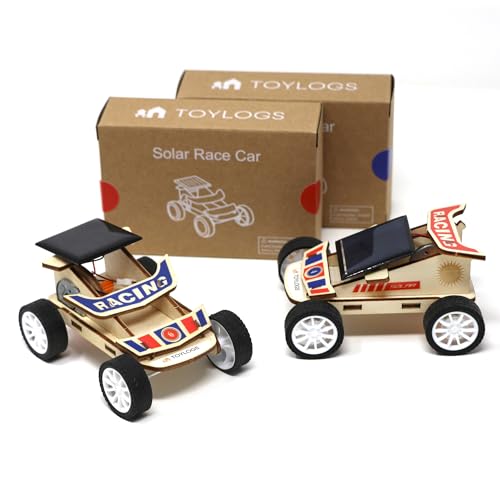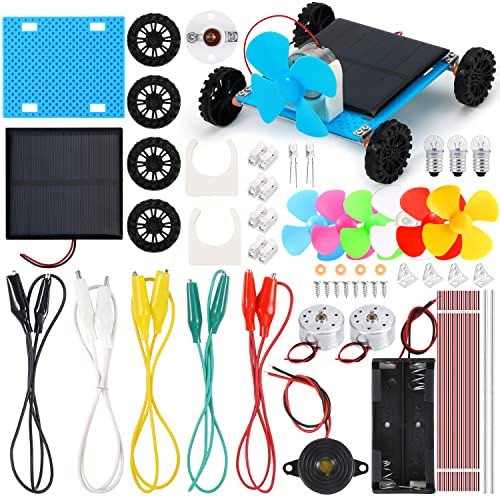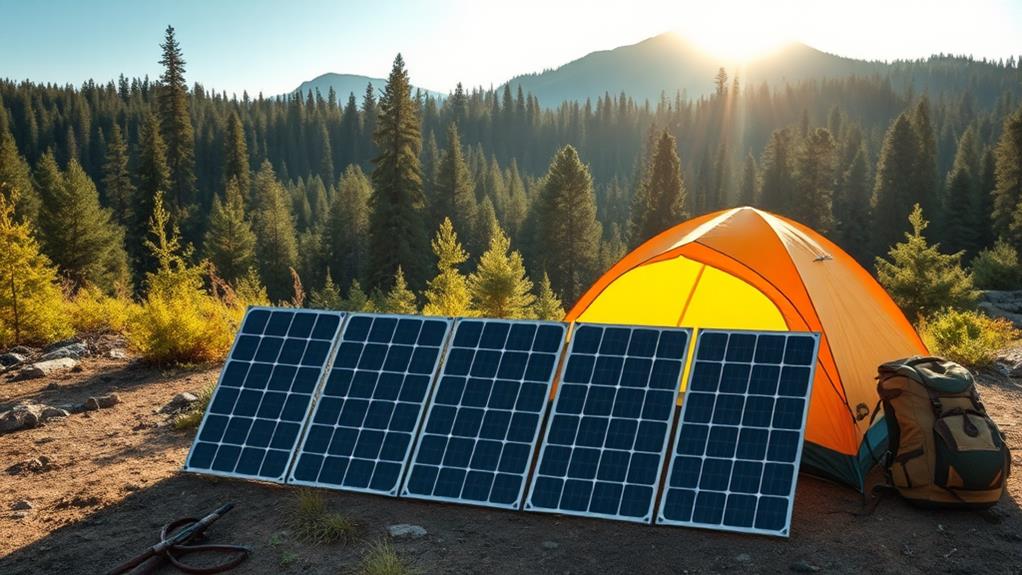Solar energy car kits offer an engaging, eco-friendly way to introduce STEM concepts to learners of all ages. These kits, designed for ages 8 and up, combine hands-on assembly with educational materials on renewable energy, physics, and engineering principles. You’ll find options ranging from simple 4-in-1 motor kits to advanced race car models, each providing unique learning experiences. Key features include non-toxic materials, detailed instruction manuals, and varying levels of complexity to suit different skill levels. When selecting a kit, consider factors such as age appropriateness, assembly complexity, solar panel efficiency, and educational objectives. Exploring these kits further will reveal the breadth of learning opportunities available in the domain of solar-powered vehicles.
Key Takeaways
- Solar energy car kits provide hands-on STEM learning experiences for children aged 8 and up.
- Top kits feature durable materials, easy assembly, and comprehensive instructions for educational value.
- High-efficiency solar panels and hybrid power options enhance performance across various light conditions.
- Kits promote eco-consciousness while teaching renewable energy concepts through practical applications.
- The best solar car kits offer a balance of educational content, assembly complexity, and engaging features for different age groups.








STEM Kits for Kids Ages 8-14, Science Experiments and Building Toys
- 4 SETS STEM KIT: These science kits contain a solar powered car, a solar powered fan, a wind powered car and a wooden plane. Each toy is individually...
- FAMILY STEM ACTIVITIES: This set of science experiments is a good way for parents and children to complete together, can also be used as a classroom...
- UNIQUE GIFT IDEA: Our stem kits designed for kids age 8-12 are cool stuff and very suitable for elementary students to show their talents in a science...
Last update on 2025-11-17 / Affiliate links / Images from Amazon Product Advertising API
If you’re looking for a hands-on way to introduce kids aged 8-14 to renewable energy and physics, these STEM kits are an excellent choice. The set includes solar-powered cars and fans, a wind-powered car, and a wooden plane, each individually packaged with all necessary components. Assembly is straightforward, requiring no welding and utilizing a provided magnetic screwdriver. These DIY projects stimulate curiosity about physics through model construction, making them ideal for both family activities and classroom STEM initiatives.
Users report that children find the assembly process engaging and educational, effectively reducing screen time while promoting hands-on learning. The kits’ versatility makes them suitable for elementary students participating in science fairs, as well as serving as unique gifts for both genders. While some users suggest including additional screwdrivers and enhancing the scientific explanations, overall feedback indicates that the projects function well and cater to diverse age groups and skill levels within the target range.
Best For: Children aged 8-14 interested in hands-on STEM learning, particularly in renewable energy and physics concepts.
Pros:
- Encourages hands-on learning and reduces screen time
- Includes all necessary components for multiple projects
- Suitable for both individual and classroom use
Cons:
- May benefit from additional screwdrivers for easier assembly
- Could include more in-depth scientific explanations
- Some users may find the projects too simple for older children in the age range
4 in 1 Solar Power & Electric Motor STEM Kit for Kids
- 【4 in 1 STEM Kit】These science kits contain a solar powered car, a solar powered fan, a wind powered car and a wooden plane. Each toy is...
- 【Family Stem Activities】This set of science experiments is a good way for parents and children to complete together, can also be used as a...
- 【Unique Gift Idea】Our stem kits designed for kids age 8-12 are cool stuff and very suitable for elementary students to show their talents in a...
Last update on 2025-11-17 / Affiliate links / Images from Amazon Product Advertising API
Budding young scientists and STEM enthusiasts will love the 4 in 1 Solar Power & Electric Motor STEM Kit. This extensive package includes a solar-powered car, solar-powered fan, wind-powered car, and wooden plane, each individually packaged with a magnetized screwdriver and detailed assembly instructions. Designed for children aged 8-12, the kit promotes hands-on learning, encouraging curiosity and interest in physics through DIY science activities and classroom STEM projects. The circuit connections are simple, requiring no welding, making it suitable for independent assembly by kids. However, users should be aware that the tiny screws may present challenges, and the provided magnetic screwdriver might not securely hold them. The solar panels output approximately 1-2 DCV, while the motors function with battery packs (not included). Once assembled, users report satisfactory performance, though caution is advised with the airplane’s sharp propeller.
Best For: Children aged 8-12 who are interested in science, engineering, and hands-on learning experiences.
Pros:
- Offers four different STEM projects in one kit, providing variety and multiple learning opportunities
- Promotes hands-on learning and encourages curiosity about physics and renewable energy
- Comes with detailed instructions and a magnetized screwdriver for easier assembly
Cons:
- Some users report difficulties with tiny screws and the magnetic screwdriver not holding them securely
- Battery packs required for motor operation are not included
- The airplane’s sharp propeller may pose a safety concern for younger children
Solar Car Solar Energy Toys for Kids (Educational Science Kit)
No products found.
For parents seeking to inspire young minds with renewable energy concepts, the Solar Car Solar Energy Toys for Kids offer an engaging educational experience. These STEM-focused kits, designed for children aged 2-10, feature miniature cars powered by solar panels that convert sunlight into electricity. The non-toxic ABS construction guarantees safety, while the smooth, edge-free components provide peace of mind for parents. With dimensions of 1.34 x 0.9 x 0.51 inches and weighing just 0.317 ounces, these compact toys are ideal for various educational settings, including summer camps and STEM activities. The product’s effectiveness is evident in its #54 ranking in Solar Power Kits on Amazon, boasting a 4.1-star rating from 12 customer reviews. While performance is optimized in strong sunlight, gentle pushing can assist movement in weaker light conditions, demonstrating practical energy conversion principles to young learners.
Best For: Parents and educators seeking to introduce children aged 2-10 to renewable energy concepts through hands-on, educational play experiences.
Pros:
- Provides a practical demonstration of solar energy conversion for young learners
- Made from non-toxic, safe materials with smooth edges for worry-free play
- Versatile educational tool suitable for various settings and occasions
Cons:
- Performance may be limited in weak sunlight conditions
- Small size (1.34 x 0.9 x 0.51 inches) may pose a choking hazard for very young children
- Recommended age range (10 years and up) conflicts with the stated target age group (2-10 years)
2 Pack Solar Mini Car DIY Sets for STEM Education
- Ages 6 and up: Designed for young learners to easily understand solar energy concepts.
- Hands-on STEM Learning: Kids explore solar energy, physics, and mechanics through play.
- Customizable Stickers: Each kit includes stickers with numbers for personalization and fun solar races.
Last update on 2025-11-17 / Affiliate links / Images from Amazon Product Advertising API
Educators and parents looking to inspire young minds will find the 2 Pack Solar Mini Car DIY Sets an excellent choice for STEM education. These kits, designed for ages 6 and up, offer a thorough hands-on learning experience in solar energy, physics, and mechanics. The sets promote exploration and understanding of scientific concepts through interactive play, making them ideal for classroom activities, camps, and birthday parties.
The DIY sets include customizable stickers with numbers, enhancing engagement during solar races and allowing for personalization. This feature makes them particularly suitable for large groups, schools, or outreach programs, fostering collaborative learning and social interaction among children. The kits’ versatility extends to various educational settings, providing opportunities for in-depth exploration of renewable energy concepts, mechanical principles, and problem-solving skills. By incorporating these solar mini car sets into STEM curricula, educators can effectively demonstrate real-world applications of scientific principles, encouraging students to think critically and innovatively about sustainable technologies.
Best For: Educators, parents, and children aged 6 and up looking for an engaging, hands-on STEM learning experience focused on solar energy and mechanics.
Pros:
- Promotes interactive learning about solar energy, physics, and mechanics
- Includes customizable stickers for personalization and enhanced engagement
- Suitable for various educational settings and group activities
Cons:
- May require adult supervision for younger children
- Limited to solar energy concept, not covering other renewable energy sources
- Potential for small parts to be lost or broken during assembly
Thames & Kosmos Solar Race Car STEM Experiment Kit
- Build a sleek race car powered by energy from the sun--no batteries required; solar panel included!
- Plastic snap-together building pieces are durable and easy to assemble.
- A system of connected gears powered by a single motor allows the car to speed up quickly.
Last update on 2025-11-17 / Affiliate links / Images from Amazon Product Advertising API
Science enthusiasts aged 8 and up will find the Thames & Kosmos Solar Race Car STEM Experiment Kit an exciting introduction to solar energy. This kit, featured in Purdue University’s 2023 INSPIRE Engineering Gift Guide, offers a hands-on approach to learning about photovoltaic technology. You’ll assemble a durable race car using 22 snap-together plastic parts, including a solar panel and motor-driven gear system for quick acceleration.
The kit’s educational value extends beyond assembly, as you’ll gain insights into solar cell functionality and real-world applications. The full-color manual provides step-by-step instructions and thorough scientific information. With a UPC of 814743016927 and an ASIN of B0BV45DGLP, this product ranks #108,975 in Toys & Games and #62 in Solar Power Kits. It’s garnered a 3.9-star rating from 45 customer reviews, indicating solid performance and educational merit.
Best For: Young science enthusiasts and STEM learners aged 8 and up who are interested in solar energy and hands-on engineering projects.
Pros:
- Provides a fun, interactive way to learn about solar power and clean energy
- Includes a comprehensive manual with scientific information and step-by-step instructions
- Features durable, easy-to-assemble components with no batteries required
Cons:
- May be too simple for older or more advanced learners
- Requires direct sunlight to function properly, limiting usage in certain conditions
- Some customers may find the price point high for a single-project kit
SOLPERK 25W 12V Solar Battery Charger for Vehicles
- 【Power Your Life with Solar】This 25W 12V solar panel is a smart and eco-friendly way to charge your 12V batteries. It is made of durable tempered...
- 【High-Efficiency Monocrystalline Cells】This solar battery charger uses premium A+ monocrystalline cells, which have a high conversion efficiency...
- 【Waterproof and Intelligent Controller】This solar trickle charger comes with a newly upgraded 8A waterproof controller, which is fully sealed and...
Last update on 2025-11-17 / Affiliate links / Images from Amazon Product Advertising API
Outdoor enthusiasts and vehicle owners seeking a reliable, eco-friendly charging solution will find the SOLPERK 25W 12V Solar Battery Charger an excellent choice. This versatile solar panel kit, designed for a wide range of vehicles including cars, RVs, boats, and motorcycles, boasts high-efficiency A+ monocrystalline cells with a conversion rate of 23%-30%. The charger’s durable construction, featuring tempered glass and an aluminum frame, guarantees a lifespan of 20-25 years while operating in temperatures from -40°F to 185°F.
Equipped with an upgraded 8A waterproof controller, the SOLPERK charger incorporates six protection functions to safeguard your battery. It’s compatible with various 12V rechargeable batteries, including LiFePO4, AGM, and GEL types. The kit comes complete with multiple connectors (alligator clips, O-rings, cigarette lighter), an adjustable installation bracket, and corner guards for flexible mounting options. With zero power consumption at night and lifetime technical support, this solar charger offers a practical, long-term solution for maintaining vehicle batteries.
Best For: Outdoor enthusiasts and vehicle owners seeking a durable, eco-friendly charging solution for maintaining 12V batteries in various vehicles and applications.
Pros:
- High-efficiency monocrystalline cells with 23%-30% conversion rate
- Versatile compatibility with multiple 12V battery types and vehicles
- Durable construction with a 20-25 year lifespan and wide temperature range
Cons:
- Limited power output at 25W, which may not be sufficient for larger vehicles or deep-cycle batteries
- Installation may require some technical knowledge or professional assistance
- Higher price point compared to non-solar battery maintainers
Children DIY Solar Power Car Toy Kit (4pcs/Set)
- [DIY for Creation]: 4 STEM projects solar car kit can be powered by the sun, for boys and girls aged 8-10 and older, improve your child's imagination...
- [No Batteries Needed]: Each of solar power cay toys includes a solar power panel that collects solar heat energy into an electric energy drive motor,...
- [Kids Safe]: All pieces of our solar motor kit are made with non-toxic ABS materials for long lasting, safe and ECO-FRIENDLY science educational toys,...
Last update on 2025-11-17 / Affiliate links / Images from Amazon Product Advertising API
Parents looking for an engaging STEM gift will find the Children DIY Solar Power Car Toy Kit an excellent choice. This 4-piece set, designed for children aged 8-10 and older, offers a thorough introduction to solar energy concepts and engineering principles. The kit includes motors, wires, connectors, solar panels, wheels, and a screwdriver, allowing young enthusiasts to construct four distinct solar-powered racers without the need for welding.
Crafted from non-toxic ABS materials, this eco-friendly and durable kit prioritizes safety with smooth edges. It promotes hands-on problem-solving, enhances manual dexterity, and fosters teamwork. The step-by-step instructions guide users through the assembly process, encouraging logical thinking and creativity. For peak performance, the solar-powered vehicles require direct sunlight and a smooth surface. This kit serves as an ideal educational tool for school STEM projects, birthdays, and holidays, providing a tangible demonstration of renewable energy in action.
Best For: Children aged 8-10 and older who are interested in STEM subjects, particularly solar energy and engineering, and enjoy hands-on learning experiences.
Pros:
- Provides an engaging, educational experience that teaches solar energy concepts and engineering principles
- Encourages creativity, problem-solving skills, and teamwork through hands-on assembly
- Made from safe, non-toxic materials with smooth edges for worry-free play
Cons:
- Requires direct sunlight for optimal performance, which may limit usage in certain conditions or locations
- May be too complex for children younger than the recommended age range
- Needs a smooth surface for the cars to operate effectively, potentially limiting where it can be used
Sntieecr Electric Circuit Motor Kit with Solar Panel for Kids
- 【Value Package】Comes with one instruction, 1 x AA size battery holder (2 x 1.5V), 1 x solar panel, 5 x crocodile clip leads, 2 x motors, 2 x motor...
- 【Science Experiment Kit】This popular and interesting electronic science experiment STEM toy can well inspire and encourage kids to learn about...
- 【Wide Applications】The circuit motor kit can well catch kids’ attention and let them try to build, experiment, and explore basic electrical...
Last update on 2025-11-17 / Affiliate links / Images from Amazon Product Advertising API
Kids with a budding interest in STEM will find the Sntieecr Electric Circuit Motor Kit an engaging introduction to solar energy and electrical circuits. This all-encompassing kit, designed for children aged 8 and up, includes a diverse array of components, such as a solar panel, motors, LED lights, and various connectors, enabling the construction of multiple experimental setups. The kit operates at a recommended voltage of 3V and incorporates safety measures, including a 3-minute usage limit to prevent overheating and short circuits. With a focus on hands-on learning, this kit facilitates the development of exploratory skills and enhances understanding of basic electrical principles through practical experimentation. Its educational value is reflected in its rankings, placing #65 in Solar Power Kits and #132 in Educational Science Kits, making it a valuable resource for school projects and STEM education initiatives.
Best For: Children aged 8 and up with an interest in STEM, particularly those curious about solar energy and electrical circuits.
Pros:
- Comprehensive kit with diverse components for multiple experiments
- Promotes hands-on learning and understanding of basic electrical principles
- Suitable for school projects and STEM education initiatives
Cons:
- Limited usage time of 3 minutes to prevent overheating
- Requires full sunlight for optimal solar panel function
- Adult supervision necessary, which may limit independent exploration
Factors to Consider When Choosing a Solar Energy Car Kit

When selecting a solar energy car kit, you’ll need to evaluate several vital factors to guarantee you’re making an informed decision. Consider the age-appropriate skill level and educational value of the kit, as these will determine its suitability for the intended user and its potential to enhance STEM learning. Additionally, assess the assembly complexity, safety features, and solar panel efficiency to gauge the kit’s overall quality, ease of use, and performance capabilities.
Age-Appropriate Skill Level
For successful and enjoyable learning experiences, choosing a solar energy car kit that matches the child’s age and skill level is vital. Most kits are designed for children aged 6-14, but it’s important to assess the complexity of assembly against the child’s developmental abilities. For younger builders, select kits with simpler designs, fewer components, and straightforward connections to foster independent learning. Kits featuring extensive instructions and visual aids can greatly enhance the building process, particularly for novice constructors.
When evaluating kits, consider their educational objectives. Some focus on fundamental physics and engineering principles, while others emphasize environmental science and renewable energy concepts. Opt for kits that offer varying levels of challenge, accommodating different interests and proficiencies. These often provide opportunities for advanced customization and experimentation, allowing children to progress as they gain confidence and skills. By carefully considering age-appropriateness, assembly requirements, instructional clarity, educational goals, and scalability of challenge, you’ll be well-equipped to select a solar energy car kit that aligns with the child’s cognitive development and promotes effective learning outcomes.
Educational Value
Building on the importance of age-appropriate selection, you’ll want to examine the educational value of solar energy car kits. These kits offer a wealth of learning opportunities, combining hands-on experiences with theoretical knowledge to make complex scientific concepts more accessible. By engaging children in the assembly and operation of solar-powered vehicles, you’re providing them with practical insights into renewable energy, physics principles, and photovoltaic technology.
Many kits come equipped with extensive educational manuals, offering in-depth explanations of the underlying scientific principles. This combination of practical application and theoretical understanding reinforces STEM education, promoting critical thinking and problem-solving skills. As children experiment with their creations, they’ll develop a deeper appreciation for engineering and mechanics, while also honing their teamwork abilities through collaborative projects. The interactive nature of these kits stimulates curiosity and creativity, encouraging young minds to explore the potential of solar energy in real-world applications. By choosing a kit with strong educational components, you’re investing in a learning tool that goes beyond mere entertainment, fostering a generation of eco-conscious, scientifically literate individuals equipped to tackle future energy challenges.
Assembly Complexity
The assembly complexity of solar energy car kits plays an essential role in your selection process. When evaluating options, consider kits that don’t require welding and are designed for easy assembly with included tools. These user-friendly designs are often suitable for children aged 8 and up, allowing for independent construction without adult assistance. However, some kits may involve more intricate connections and tiny screws, which can present challenges for younger builders.
To mitigate assembly difficulties, look for kits that provide detailed step-by-step instructions and include helpful features such as magnetic screwdrivers. These elements can notably enhance the learning experience and facilitate a smoother building process. Additionally, consider the types of projects included in the kit. Simpler designs may promote confidence and enjoyment, particularly for beginners, while more complex models offer greater challenges and deeper learning opportunities. By carefully evaluating the assembly complexity, you’ll be able to choose a solar energy car kit that aligns with the builder’s skill level and educational goals, ensuring an engaging and rewarding experience in eco-friendly technology exploration.
Safety Features
While assembly complexity is important, safety features should be at the forefront of your decision-making process when selecting a solar energy car kit. When evaluating options, prioritize kits that utilize non-toxic, durable materials to guarantee safe playtime experiences. Inspect the components for smooth edges and absence of raw surfaces, which can prevent injuries during assembly and operation. Additionally, verify that vital elements, such as motors and solar panels, are securely designed to avoid detachment during use, mitigating potential safety hazards.
Scrutinize the kit’s documentation for thorough safety warnings and guidelines, including recommended voltage limits and usage parameters to prevent overheating and short circuits. Opt for products that emphasize adult supervision, particularly for younger users, to guarantee safe experimentation with electronic components. This oversight is essential for maintaining a secure environment during the assembly and operational phases. By carefully considering these safety aspects, you’ll be able to select a solar energy car kit that not only provides an educational experience but also prioritizes the well-being of its users. Remember, a well-designed kit should balance engaging complexity with robust safety features to deliver a superior learning experience.
Solar Panel Efficiency
When it comes to selecting a solar energy car kit, solar panel efficiency stands out as an essential factor to evaluate. Solar panel efficiency, typically measured by the conversion rate, indicates the percentage of sunlight that can be transformed into usable electricity. High-efficiency panels boast conversion rates ranging from 23% to 30%, offering maximum performance for your solar-powered vehicle. You’ll want to take into account the type of solar cells utilized in the kit, as this greatly impacts overall efficiency. Environmental conditions play a significant role, too; panels perform best in direct sunlight, with output decreasing in shaded or cloudy conditions. The angle and orientation of the panels relative to the sun’s position are equally important for maximizing energy capture. To maintain peak efficiency, you’ll need to keep the panel surfaces clean, as accumulated dirt and debris can considerably reduce effectiveness. When evaluating kits, look for those incorporating cutting-edge technologies, such as bifacial solar panels, which capture sunlight from both sides, enhancing energy generation capabilities. By prioritizing solar panel efficiency in your selection process, you’ll guarantee maximum performance and longevity for your solar energy car kit.
Additional Power Options
Beyond solar panel efficiency, additional power options play a key role in selecting the best solar energy car kit. Many manufacturers now incorporate hybrid designs that combine solar energy with electric motors powered by rechargeable batteries, enhancing the kit’s versatility and performance. These battery packs serve a dual purpose: storing excess solar energy for later use and allowing operation in low-light conditions. This feature guarantees consistent functionality, even during cloudy weather or indoor use.
Some advanced kits offer the integration of alternative power sources, such as wind energy, further diversifying energy input and improving overall effectiveness. Additionally, manual wind-up mechanisms may be included, providing a hands-on demonstration of mechanical energy conversion and promoting educational exploration of hybrid energy solutions. When evaluating solar car kits, consider those with multiple power options to maximize usability and learning potential. Look for kits that allow seamless switching between solar, battery, and alternative power sources, as this flexibility enhances the educational value and practical application of the product. By choosing a kit with diverse power options, you’ll guarantee a more thorough understanding of renewable energy systems and their real-world applications.
Durability and Materials
Durability and material quality frequently determine the long-term value of a solar energy car kit. When evaluating options, prioritize kits that utilize non-toxic ABS plastic, a material renowned for its safety and durability in children’s educational toys. High-quality, weather-resistant components are essential, particularly if the kit will be exposed to outdoor conditions. Assess the construction of the kit, paying close attention to the smoothness of edges and connections, as well-designed parts minimize injury risks and facilitate a superior assembly process.
The longevity of materials serves as a key indicator of overall durability. For instance, premium solar panels can maintain functionality for 20-25 years under ideal conditions. To gauge real-world performance, examine user reviews that discuss the kit’s resilience after repeated use. This feedback often provides valuable insights into the product’s durability and potential weaknesses. By selecting a kit with robust materials and construction, you’ll guarantee a longer-lasting educational experience. Remember, the initial investment in a higher-quality kit often translates to extended usability and enhanced learning opportunities, making it a cost-effective choice for both educators and enthusiasts.
Included Accessories
Examining the included accessories in a solar energy car kit reveals vital factors for making an informed choice. When evaluating these kits, you’ll want to focus on the core components: solar panels, motors, wheels, and connectors. These elements are essential for constructing a functional solar-powered vehicle. Additionally, look for kits that provide detailed instruction manuals and supplementary tools, such as screwdrivers or crocodile clips, which can greatly enhance the assembly process and overall learning experience.
Safety should be a top priority, especially if children will be using the kit. Confirm that the included materials are non-toxic and feature smooth edges to prevent injuries during handling and construction. Customization options, like stickers or interchangeable parts, can boost engagement and foster creativity, making the assembly process more enjoyable and educational. It’s also vital to verify the solar panels’ compatibility with various light conditions. Some kits may require direct sunlight for peak performance, while others might function effectively under artificial light sources. By carefully considering these accessory-related factors, you’ll be better equipped to select a solar energy car kit that provides a thorough, safe, and engaging learning experience.
Frequently Asked Questions
Are Solar Energy Car Kits Suitable for Use in Cloudy or Rainy Weather?
Solar energy car kits aren’t ideally suited for cloudy or rainy conditions. You’ll find their performance considerably diminished in low-light environments. Photovoltaic cells require direct sunlight to generate electricity efficiently. In overcast weather, the power output can drop by 50-90%, depending on cloud density. Some kits may include capacitors or batteries to store energy, allowing for limited operation during brief periods of low light. However, for consistent performance, you’ll need clear, sunny conditions.
Can Solar Energy Car Kits Be Used to Power Real Vehicles?
You can’t use solar energy car kits to power real vehicles directly. These kits are designed for educational and demonstrational purposes, typically powering small-scale models. Real solar-powered vehicles require much larger, more efficient photovoltaic arrays and complex energy management systems. However, the principles demonstrated in these kits, such as solar cell operation and energy conversion, are applicable to full-scale solar vehicle development. For practical applications, you’d need to explore commercial-grade solar technologies designed specifically for automotive use.
How Long Do the Batteries in Solar Energy Car Kits Typically Last?
The battery longevity in solar energy car kits varies depending on the type and capacity used. You’ll typically find rechargeable NiMH or Li-ion batteries, ranging from 300mAh to 2000mAh. These can last anywhere from 30 minutes to several hours of continuous operation. Factors affecting battery life include the motor’s power consumption, solar panel efficiency, and usage patterns. It’s crucial to understand that with proper care and regular solar charging, you can extend the overall lifespan of these batteries to several years.
Are There Any Safety Concerns When Using Solar Energy Car Kits?
When using solar energy car kits, you’ll need to take into account several safety aspects. Guarantee proper handling of small parts to prevent choking hazards, especially for young users. Be cautious of sharp edges on metal components and potential electrical risks from exposed wires or connections. You should also be aware of overheating issues in direct sunlight and the possibility of battery leakage. Always follow manufacturer’s guidelines, supervise children during use, and wear protective gear when necessary to mitigate these risks.
Can Solar Energy Car Kits Be Used for School Science Fair Projects?
You’ll find solar energy car kits to be excellent resources for science fair projects, offering hands-on learning in renewable energy, electrical engineering, and mechanical design. These kits provide opportunities to explore concepts such as photovoltaic conversion, energy storage, and motor efficiency. You can conduct experiments on factors affecting solar panel performance, optimize car design for speed or endurance, and analyze energy conversion rates. Additionally, you’ll develop skills in data collection, analysis, and presentation, enhancing your project’s overall scientific rigor and educational value.
















